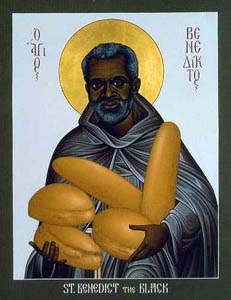4월 04일
상토 필라델포의 성 베네딕토 니그리 수도자, 1회

St. Benedict the Black 1526-1589
The parents of St. Benedict were Negroes from Africa, who had been brought as slaves to San Fratello, a village in Sicily. There they embraced the Christian faith, and lived so exemplary a life in the fulfillment of all their duties that their master granted Benedict, their eldest son, his freedom. From his youth, Benedict was especially God-fearing. He was austere towards his body, not only through constant labor, but also through various types of voluntary mortification. He served his former master for a wage, and when he had saved enough, be bought a pair of oxen, with which he plowed as a day laborer. Because of his black skin and his lowly origin, he was often mocked and despised by his fellow laborers. He became acquainted with some hermits who followed the rule of St. Francis, their life so attracted him that he sold his small possessions, gave everything to the poor, and also led the life of a hermit in the vicinity of Palermo. Until he was 40 years old he served God in this manner in the practice of every virtue and austerity. Then an order was issued by Pope Pius IV that all hermits following the rule of St. Francis should betake themselves to one of the convents of the order. Immediately Benedict went to the convent of the Friars Minor at Palermo, and there continued to perform his former pious exercises in addition to the heavy work which he gladly took upon himself. After the example of our holy Father St. Francis, he observed the forty days' fast 7 times a year, he slept only a few hours on the bare floor, and wore a very course habit. Poverty and chastity he loved and guarded most scrupulously.
Because he was a model for all the brethren of the convent, he was appointed their superior, even though he was only a lay brother without any schooling. His holy example, his humble charity and self-abnegation had the effect that not only did no one despise him in his office, but rather was he venerated by all, and the inmates of the convent advanced in all virtue during his administration. At the expiration of his term of office, he went back to his duties in the kitchen with greater joy than he had previously entered upon his duties as superior.
In his 63rd year he was attacked by severe illness, which he recognized as his last. With profound devotion he received the last rites of the Church, and departed this life on April 4, 1589, at the hour he had foretold. Several years later his body was found still incorrupt, and emitting a pleasant odor. Veneration for him soon spread from Palermo through Italy, to Spain and Portugal, even to Brazil, Mexico, and Peru. Pope Benedict XIV declared him blessed, and Pius VII solemnly placed him in the ranks of the saints in the year 1807.
 4월 21일 파르잠의 성 콘라도 수도자, 1회
4월 21일 파르잠의 성 콘라도 수도자, 1회



